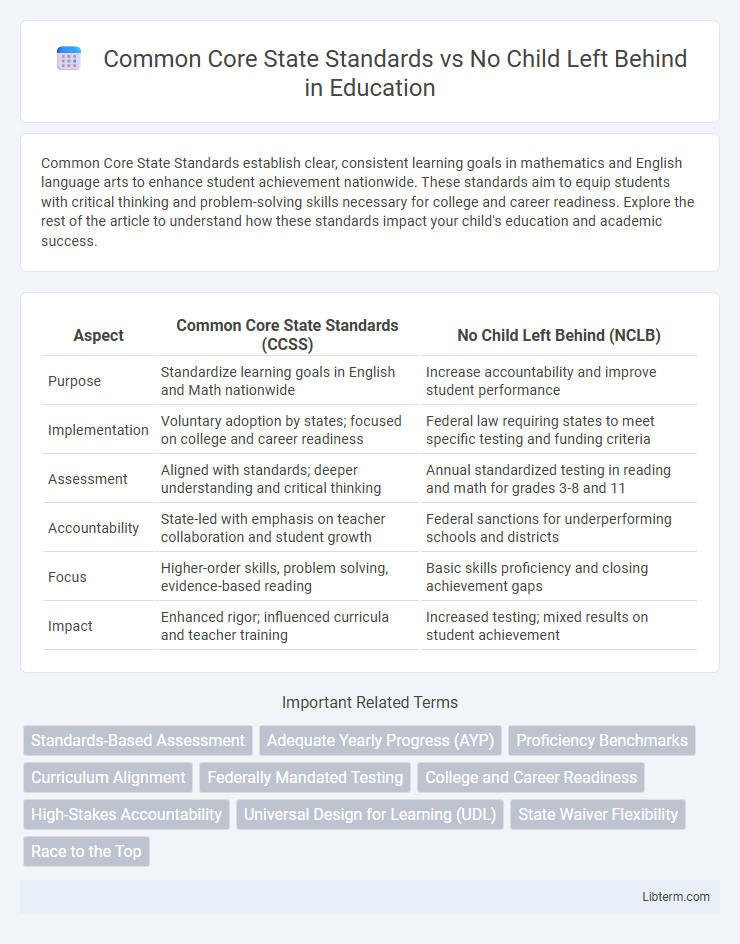Common Core State Standards establish clear, consistent learning goals in mathematics and English language arts to enhance student achievement nationwide. These standards aim to equip students with critical thinking and problem-solving skills necessary for college and career readiness. Explore the rest of the article to understand how these standards impact your child's education and academic success.
Table of Comparison
| Aspect | Common Core State Standards (CCSS) | No Child Left Behind (NCLB) |
|---|---|---|
| Purpose | Standardize learning goals in English and Math nationwide | Increase accountability and improve student performance |
| Implementation | Voluntary adoption by states; focused on college and career readiness | Federal law requiring states to meet specific testing and funding criteria |
| Assessment | Aligned with standards; deeper understanding and critical thinking | Annual standardized testing in reading and math for grades 3-8 and 11 |
| Accountability | State-led with emphasis on teacher collaboration and student growth | Federal sanctions for underperforming schools and districts |
| Focus | Higher-order skills, problem solving, evidence-based reading | Basic skills proficiency and closing achievement gaps |
| Impact | Enhanced rigor; influenced curricula and teacher training | Increased testing; mixed results on student achievement |
Introduction: Understanding Education Reform
Common Core State Standards (CCSS) establish clear, consistent academic benchmarks for K-12 students across participating states, emphasizing critical thinking and problem-solving skills in English Language Arts and Mathematics. No Child Left Behind (NCLB) was a federal law focused on accountability, standardized testing, and closing achievement gaps through annual assessments and adequate yearly progress requirements. Understanding these education reforms highlights the shift from compliance-driven policies under NCLB to skill-focused, college- and career-ready standards promoted by CCSS.
Overview of Common Core State Standards
The Common Core State Standards (CCSS) establish clear, consistent academic benchmarks in English language arts and mathematics for K-12 students, promoting college and career readiness nationwide. Unlike No Child Left Behind (NCLB), which focused heavily on standardized testing and accountability measures, CCSS emphasizes critical thinking, problem-solving skills, and conceptual understanding. Implemented in over 40 states, CCSS aims to provide a cohesive framework that prepares students for higher education and competitive job markets.
Key Principles of No Child Left Behind
No Child Left Behind (NCLB) centers on accountability, standardized testing, and closing achievement gaps by requiring states to develop assessments in reading and math for grades 3-8 and once in high school. The law mandates Adequate Yearly Progress (AYP), linking federal funding to measurable student performance and emphasizing interventions for failing schools. Unlike Common Core State Standards, which provide consistent learning goals, NCLB primarily enforces testing and consequences to improve educational outcomes nationwide.
Comparing Educational Goals
Common Core State Standards emphasize developing critical thinking and problem-solving skills through rigorous, consistent benchmarks in math and English language arts. No Child Left Behind prioritizes standardized testing and accountability measures to ensure all students meet minimum proficiency levels in reading and math. The Core Standards aim for college and career readiness, while NCLB focuses on closing achievement gaps and raising basic academic performance.
Curriculum and Assessment Differences
Common Core State Standards emphasize clear, consistent learning goals in English language arts and mathematics, promoting critical thinking and problem-solving skills that align with college and career readiness. In contrast, No Child Left Behind prioritized standardized testing mainly in reading and math to evaluate school performance, often leading to a narrowed curriculum focused on test preparation. Assessment under Common Core involves performance-based and formative evaluations designed to measure deeper understanding, whereas No Child Left Behind relied heavily on annual high-stakes standardized tests.
State vs Federal Control in Education
The Common Core State Standards (CCSS) represent a state-led initiative aimed at creating consistent academic benchmarks across states, emphasizing state control over curriculum development and implementation. In contrast, the No Child Left Behind Act (NCLB) was a federal mandate enforcing accountability through standardized testing and federal oversight, exemplifying centralized federal control in education policy. This divergence highlights the ongoing debate between state autonomy in setting educational priorities and federal authority in ensuring nationwide academic accountability.
Impact on Teachers and Classrooms
Common Core State Standards (CCSS) shifted classroom instruction to deeper critical thinking and problem-solving skills, requiring teachers to redesign lesson plans and assessments to align with more rigorous, uniform benchmarks. No Child Left Behind (NCLB) emphasized accountability through standardized testing, often narrowing curricula and increasing test preparation time, which led to greater pressure and reduced instructional flexibility for educators. The CCSS fostered professional collaboration among teachers to integrate complex skills, whereas NCLB primarily drove data-driven instruction focused on improving test scores.
Student Outcomes and Achievement
Common Core State Standards (CCSS) emphasize critical thinking and problem-solving skills, aiming to elevate student outcomes by providing clear, consistent expectations across states. No Child Left Behind (NCLB) focused primarily on standardized test proficiency and accountability measures, often resulting in narrowed curricula to meet benchmarks. Research indicates CCSS fosters deeper understanding and long-term academic achievement, while NCLB's approach emphasized short-term improvements in test scores.
Criticisms and Controversies
Common Core State Standards (CCSS) faced criticism for being federally influenced despite claims of state-led development, resulting in debates over curriculum control and implementation costs. No Child Left Behind (NCLB) attracted controversy for its heavy reliance on standardized testing, leading to teaching to the test and schools being penalized unfairly. Both initiatives sparked concerns about narrowing educational focus and insufficient attention to diverse student needs.
The Future of U.S. Education Policy
The future of U.S. education policy is increasingly shaped by the transition from No Child Left Behind (NCLB) to the Common Core State Standards (CCSS), emphasizing college and career readiness through uniform benchmarks in English Language Arts and Mathematics. States adopting CCSS prioritize critical thinking, problem-solving, and analytical skills over the test-focused accountability measures central to NCLB. This shift aligns educational goals with global competitiveness and personalized learning, signaling a move toward more comprehensive, student-centered policy frameworks in American education.
Common Core State Standards Infographic

 libterm.com
libterm.com